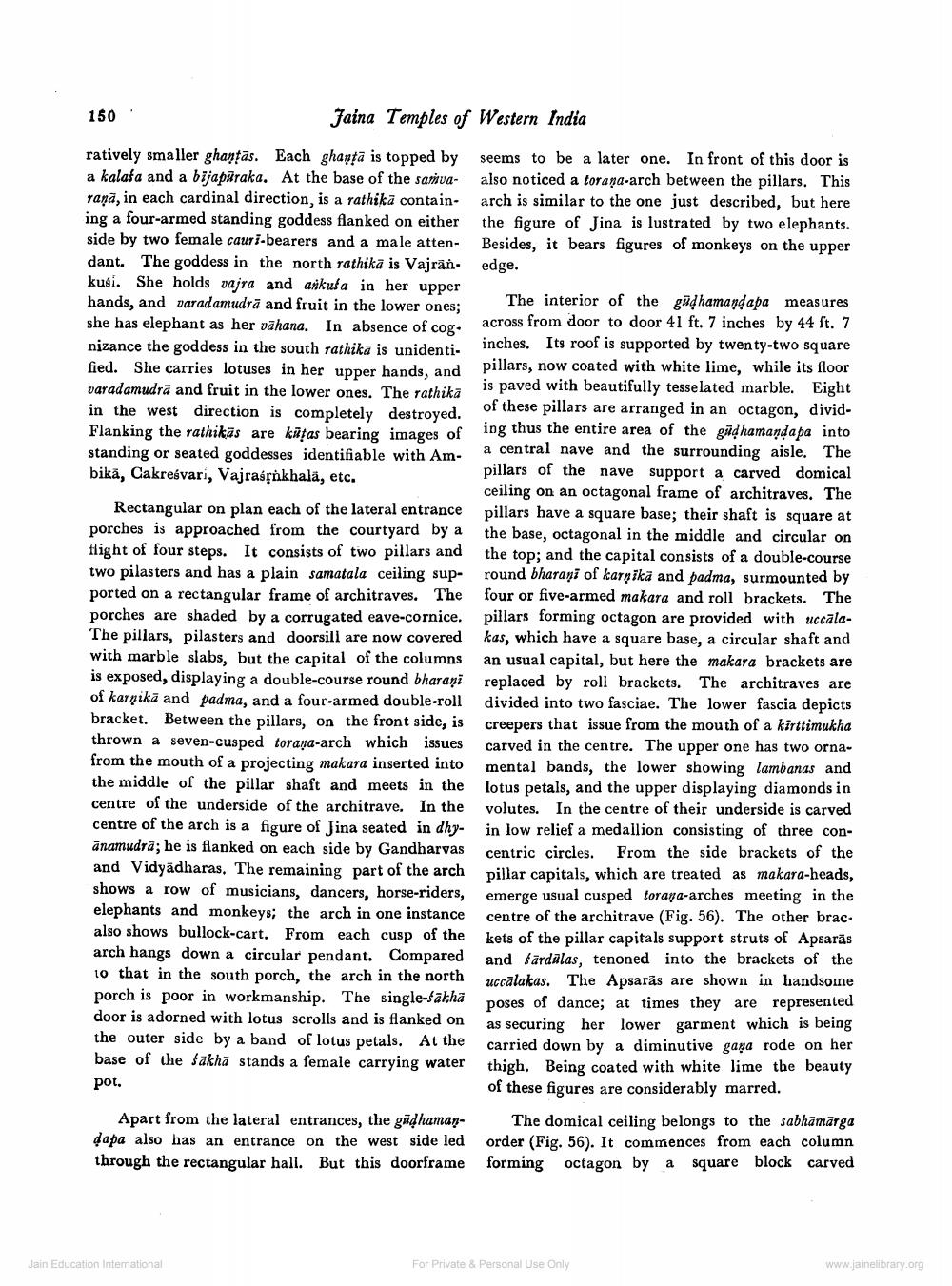________________
150
Faina Temples of Western India
ratively smaller ghanțās. Each ghanga is topped by seems to be a later one. In front of this door is a kalata and a bijapāraka. At the base of the samva- also noticed a torana-arch between the pillars. This taņā, in each cardinal direction, is a rathika contain- arch is similar to the one just described, but here ing a four-armed standing goddess flanked on either the figure of Jina is lustrated by two elephants. side by two female cauri-bearers and a male atten- Besides, it bears figures of monkeys on the upper dant. The goddess in the north rathika is Vajran. edge. kusi. She holds vajra and ankuta in her upper hands, and varad amudrā and fruit in the lower ones;
The interior of the gūdhamandapa measures she has elephant as her vāhana. In absence of cog.
across from door to door 41 ft. 7 inches by 44 ft. 7 nizance the goddess in the south rathika is unidenti.
inches. Its roof is supported by twenty-two square fied. She carries lotuses in her upper hands, and
pillars, now coated with white lime, while its floor varadamudra and fruit in the lower ones. The rathika
is paved with beautifully tesselated marble. Eight in the west direction is completely destroyed.
of these pillars are arranged in an octagon, dividFlanking the rathikās are kūtas bearing images of
ing thus the entire area of the gūdhamandapa into standing or seated goddesses identifiable with Am
a central nave and the surrounding aisle. The bika, Cakreśvari, Vajraspökhala, etc.
pillars of the nave support a carved domical
ceiling on an octagonal frame of architraves. The Rectangular on plan each of the lateral entrance pillars have a square base; their shaft is square at porches is approached from the courtyard by a the base, octagonal in the middle and circular on flight of four steps. It consists of two pillars and the top; and the capital consists of a double-course two pilasters and has a plain samatala ceiling sup- round bharaṇi of karnikā and padma, surmounted by ported on a rectangular frame of architraves. The four or five-armed makara and roll brackets. The porches are shaded by a corrugated eave-cornice. pillars forming octagon are provided with uccalaThe pillars, pilasters and doorsill are now covered kas, which have a square base, a circular shaft and with marble slabs, but the capital of the columns an usual capital, but here the makara brackets are is exposed, displaying a double-course round bharani replaced by roll brackets. The architraves are of karnikā and padma, and a four-armed double-roll divided into two fasciae. The lower fascia depicts bracket. Between the pillars, on the front side, is creepers that issue from the mouth of a kiritimukha thrown a seven-cusped torașa-arch which issues carved in the centre. The upper one has two ornafrom the mouth of a projecting makara inserted into mental bands, the lower showing lambanas and the middle of the pillar shaft and meets in the lotus petals, and the upper displaying diamonds in centre of the underside of the architrave. In the volutes. In the centre of their underside is carved centre of the arch is a figure of Jina seated in dhy in low relief a medallion consisting of three conānamudra; he is flanked on each side by Gandharvas centric circles. From the side brackets of the and Vidyadharas. The remaining part of the arch pillar capitals, which are treated as makara-heads, shows a row of musicians, dancers, horse-riders, emerge usual cusped torana-arches meeting in the elephants and monkeys; the arch in one instance centre of the architrave (Fig. 56). The other bracalso shows bullock-cart. From each cusp of the kets of the pillar capitals support struts of Apsarās arch hangs down a circular pendant. Compared and färdalas. tenoned into the brackets of the 10 that in the south porch, the arch in the north uccālakas. The Apsarās are shown in handsome porch is poor in workmanship. The single-fākha poses of dance; at times they are represented door is adorned with lotus scrolls and is flanked on
as securing her lower garment which is being the outer side by a band of lotus petals. At the carried down by a diminutive gaña rode on her base of the fakhā stands a female carrying water thigh. Being coated with white lime the beauty
of these figures are considerably marred. Apart from the lateral entrances, the gadhaman- The domical ceiling belongs to the sabhämärga dapa also has an entrance on the west side led order (Fig. 56). It commences from each column through the rectangular hall. But this doorframe forming octagon by a square block carved
pot,
Jain Education International
For Private & Personal Use Only
www.jainelibrary.org




